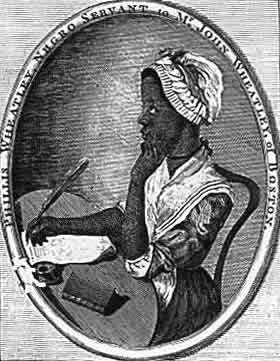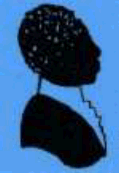Poetry
I have never been a fan of poetry, so it is not surprising that I knew next to nothing about slave poets. It never crossed my mind that if slaves were writing narratives about their lives then they were probably writing other forms of literature. I never thought of poetry as a form in which slaves could resist slavery. Upon being introduced to Phillis Wheatley, I learned how wrong I was. Her poems were beautifully written, and at first glance seemed innocent enough. However, after the class analyzed her poem "On Being Brought from Africa to America," I discovered new ways of looking at her poems. They were forms of expression, but also another form of slavery. Others controlled what she was able to write about and whether what she wrote should even be considered literature. Despite her limitations, she exposed contradictions in the law and raised questions about the situation of African Americans within society. She raised many questions within the texts of her poems. How could America, as a nation, fight for its freedom when not all its people were free?
The questions her poems raised caused me to further my knowledge about slavery and poetry. While researching, I found information on George Moses Morton. His poem addressed topics about slavery in ways that Wheatley could not. Looking at these two poets side by side made me realize how unrecognized Wheatley's poetry is. Morton is praised for his outspoken poems about slavery, a luxury that Wheatley did not have. I think it would be very interesting to analyze these two poets and see how Morton's predecessor influenced his writing. By analyzing Wheatley with other poets, we might find new interpretations of her works. Overall, the field of slave poetry is one that deserves more study and reflection.
Phillis Wheatley (1753-1784)
 Phillis Wheatley was born in Africa (probably Senegal) about 1753 or 1754. When she was about seven or eight years old, she was kidnapped and brought to Boston. There, in 1761, John Wheatley bought her for his wife, Susanna, as a personal servant. As was the custom of the time, she was given the Wheatley family's surname.
Phillis Wheatley was born in Africa (probably Senegal) about 1753 or 1754. When she was about seven or eight years old, she was kidnapped and brought to Boston. There, in 1761, John Wheatley bought her for his wife, Susanna, as a personal servant. As was the custom of the time, she was given the Wheatley family's surname.
The Wheatley family taught Phillis English and Christianity, and, impressed by her quick learning, they also taught her some Latin, ancient history, mythology and classical literature. Her situation allowed her time to learn and, as early as 1765, to write poetry. Her first poem was published when she was only 13.
Although Phillis Wheatley had fewer restrictions than most slaves, she was still a slave. Because of her situation, she was isolated. She was not quite part of the white Wheatley family, nor did she quite share the place and experiences of other slaves. Her literary abilities were constantly questioned by those who had authority over her, and in 1772 she was forced to go to court to defend her authentic and original works. In order for her book of poems to be published, she had to sign an attestation which was included in the preface of Poems of Various Subjects, Religious and Moral.
Around 1778, shortly after her master died, Phillis was freed. She married a free black man named John Peters. Meanwhile, the Revolutionary War continued to ravage the land and caused many problems for Phillis' marriage, which was unstable. The family had little money and had already lost two children. Eventually, John deserted her, and Phillis began to work as a scullery maid in a boardinghouse in order to provide for her sole surviving child. On December 5, 1784, Phillis died. Within hours of her death, her third child died.
The last poem she ever wrote was for George Washington, and her second volume of poetry was lost after her death. She is the first slave poet as well as the first African American woman poet.
Poem Texts
- Project Gutenberg Edition: Poems on Various Subjects, Religious and Moral
- Renascence Edition: Poems on Various Subjects, Religious and Moral
Information
George Moses Horton (1797-1883)
 George Moses Horton was born in slavery about 1797 on William Horton's tobacco plantation in Northampton Country, North Carolina. He grew up as a cow-hand in Chatham county and educated himself to read scripture and write poems. In 1814 he was given to William's son James, at whose death in 1843 he passed to James's son Hall.
George Moses Horton was born in slavery about 1797 on William Horton's tobacco plantation in Northampton Country, North Carolina. He grew up as a cow-hand in Chatham county and educated himself to read scripture and write poems. In 1814 he was given to William's son James, at whose death in 1843 he passed to James's son Hall.
By the time he was twenty, George Moses Horton had begun visiting the campus of The University of North Carolina eight miles away. There he sold students acrostics on the names of their sweethearts at twenty-five, fifty, and seventy-five cents. For several decades he "bought his time" from his masters through the sale of his poems and through the wages collected as a campus laborer. Caroline Lee Hentz, novelist and professor's wife, encouraged him. She helped George get some of his poems published in local newspapers. He transmitted his poems orally and needed someone else to write them down. This publicity led both to a failed campaign to raise enough money to free Horton, and to his first book. J. Gales and Son, in Raleigh, published 21 of his poems in a book entitled The Hope of Liberty in 1829.
In 1845 Dennis Heartt of the Hillsborough Recorder brought out The Poetical Works of George M. Horton, The Colored Bard of North-Carolina, To Which Is Prefixed The Life of the Author, Written by Himself. Seldom was Horton without a manuscript for which he was gathering subscriptions from admiring students and friends. In April 1865 he attached himself to Captain Will H.S. Banks, and thereafter followed Banks's Michigan cavalry unit to Lexington and Concord. Banks sponsored Horton's third book, Naked Genius, published several months later from the press of William B. Smith in Raleigh. Afterwards he went north to Philadelphia and is last heard of in 1883. No death notice has been found. He was survived by a son, Free Snipes, and a daughter, Rhody, who remained in North Carolina.
Poem Texts
- The Poetic Works of George M. Horton, the Colored Bard of North Carolina
- Selected Poems of George Moses Horton
Information
Additional Sources
While researching, I found additional information about slavery and poetry. The links are included for those who want to do further research on the subject matter.